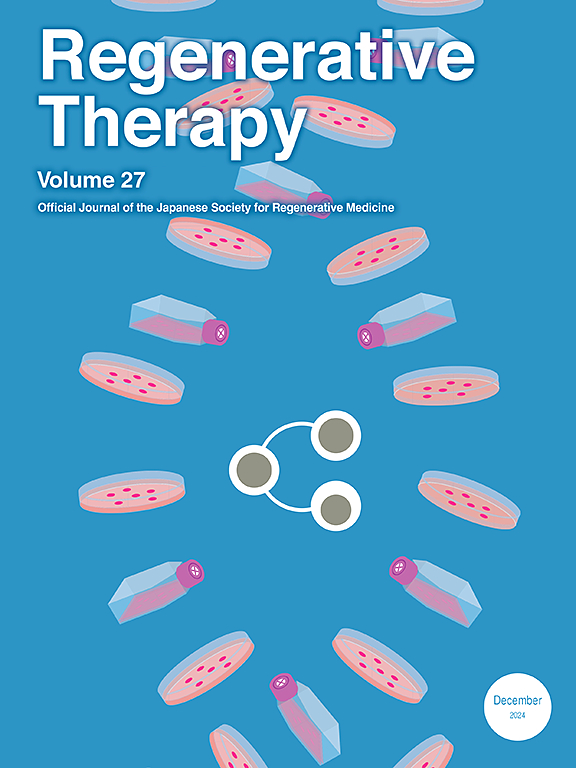装载miR-375的大鼠脂肪源性间充质干细胞源性外泌体通过靶向EPHA4激活Akt促进神经突生长和周围神经再生
IF 3.5
3区 环境科学与生态学
Q3 CELL & TISSUE ENGINEERING
引用次数: 0
摘要
间充质干细胞(MSCs)来源的外泌体携带的micrornas (miRNAs)参与周围神经再生。我们的研究旨在确定脂肪源性间充质干细胞(ADMSCs)分泌的mir -375负载外泌体在体外和坐骨神经损伤大鼠模型中背根神经节(DRG)神经元中的作用及其潜在机制。方法分离大鼠原代ADMSCs和DRG神经元后,采用western blotting和纳米颗粒跟踪分析鉴定ADMSCs衍生外泌体的特征。将MiR-375模拟物或NC模拟物转染到ADMSCs中,制备exo-miR-375或exo-NC。然后,将DRG神经元与exo-miR-375或exo-NC共培养,通过神经丝免疫荧光染色和RT-qPCR分析装载miR-375的外泌体对轴突延伸的影响。通过行走轨迹分析来评估注射exo-miR-375或exo-NC对大鼠坐骨神经功能恢复的影响。通过甲苯胺蓝染色、透射电镜(TEM)和神经丝免疫荧光染色观察损伤神经轴突和髓鞘纤维再生情况。TargetScan和miRDB数据库用于筛选miR-375下游靶基因。通过双荧光素酶报告基因实验验证miR-375与EPHA4的相互作用关系。western blotting检测坐骨神经组织Akt磷酸化水平。结果miR-375过表达的admscs来源外泌体刺激大鼠坐骨神经损伤后轴突延伸,增强DRG神经元神经营养因子表达,改善肢体功能恢复,促进轴突髓鞘纤维再生,减轻腓骨肌萎缩。miR-375靶向的EPHA4。在体外,过表达EPHA4逆转了exo-miR-375对神经突生长的促进。此外,exo-miR-375显著降低了大鼠坐骨神经中EPHA4的水平,但升高了磷酸化akt的水平。结论miR-375过表达的admscs外泌体通过下调EPHA4激活Akt,促进神经突生长和周围神经再生。本文章由计算机程序翻译,如有差异,请以英文原文为准。
Rat adipose-derived mesenchymal stem cell-derived exosomes loaded with miR-375 promote neurite outgrowth and peripheral nerve regeneration via activation of Akt by targeting EPHA4
Background
MicroRNAs (miRNAs) carried by mesenchymal stem cells (MSCs)-derived exosomes participate in peripheral nerve regeneration. Our study intended to determine the role of miR-375-loaded exosomes secreted by adipose-derived MSCs (ADMSCs) in dorsal root ganglion (DRG) neurons in vitro and in rat models of sciatic nerve injury as well as the underlying mechanisms.
Methods
After the isolation of primary rat ADMSCs and DRG neurons, the characteristics of ADMSC-derived exosomes were identified by western blotting and nanoparticle tracking analysis. MiR-375 mimics or NC mimics were transfected into ADMSCs to prepare exo-miR-375 or exo-NC. Then, DRG neurons were co-cultured with exo-miR-375 or exo-NC to analyze the influence of exosomes loaded with miR-375 on axon extension by neurofilament immunofluorescence staining and neurotrophic factor production by RT-qPCR. A walking track analysis was conducted to assess the effects of exo-miR-375 or exo-NC injection on the recovery of rat sciatic nerve functions. Axon and myelinated fiber regeneration in injured nerves was observed through toluidine blue staining, transmission electron microscopy (TEM), and neurofilament immunofluorescence staining. TargetScan and miRDB databases were used to screen for miR-375 downstream target genes. The miR-375 and EPHA4 interaction relationship was validated through dual luciferase reporter assay. The phosphorylation of Akt in sciatic nerve tissues was determined via western blotting.
Results
ADMSCs-derived exosomes with overexpressed miR-375 stimulated axon extension and enhanced neurotrophic factor expression in DRG neurons as well as improved limb function recovery, facilitated axon myelinated fiber regeneration, and alleviated gastrocnemius muscle atrophy in rats after sciatic nerve injury. EPHA4 targeted by miR-375. Overexpressing EPHA4 reversed the promotion of exo-miR-375 on neurite outgrowth in vitro. Additionally, exo-miR-375 significantly reduced EPHA4 levels but elevated phosphorylated-Akt levels in rat sciatic nerves.
Conclusion
ADMSCs-derived exosomes with overexpressed miR-375 promoted neurite outgrowth and peripheral nerve regeneration by activating Akt through downregulating EPHA4.
求助全文
通过发布文献求助,成功后即可免费获取论文全文。
去求助
来源期刊

Regenerative Therapy
Engineering-Biomedical Engineering
CiteScore
6.00
自引率
2.30%
发文量
106
审稿时长
49 days
期刊介绍:
Regenerative Therapy is the official peer-reviewed online journal of the Japanese Society for Regenerative Medicine.
Regenerative Therapy is a multidisciplinary journal that publishes original articles and reviews of basic research, clinical translation, industrial development, and regulatory issues focusing on stem cell biology, tissue engineering, and regenerative medicine.
 求助内容:
求助内容: 应助结果提醒方式:
应助结果提醒方式:


